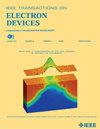平面纳米级真空/空气通道电子管的背栅调制阴极
IF 2.9
2区 工程技术
Q2 ENGINEERING, ELECTRICAL & ELECTRONIC
引用次数: 0
摘要
纳米级真空/空气通道电子管(VET)因其在高温和高频工作环境中的卓越性能而不断涌现。然而,在真空/气道电子管中,栅极边缘场的调制效率较低,漏电或累积不可忽略,与集成电路(IC)技术的兼容性较差,这些都限制了真空/气道电子管集成电路的实现。本研究提出了一种独创的阴极调制 VET(CMVET),通过背栅直接调节阴极的电子密度,从而有效控制阴极的场发射电流,进而调节阳极电流。因此,我们获得了跨导为 4.6 \; \mu $ S 的 CMVET 器件,并抑制了不超过 10^{-{11}}$ A 的栅极漏电流,该器件完全采用传统微电子工艺制作,与集成电路工艺兼容。在此基础上,有望实现抗高频、高温和高辐射的 CMVET 集成电路。本文章由计算机程序翻译,如有差异,请以英文原文为准。
Modulating the Cathode by Back-Gate for Planar Nanoscale Vacuum/Air Channel Electron Tube
Nanoscale vacuum/air channel electron tubes (VETs) keep emerging owing to their superior performance in high-temperature and high-frequency working environments. However, in VETs the edge field of the gate with inferior modulation efficiency, nonnegligible leakage or accumulation, and poor compatibility with integrated circuits (ICs) technology limits the realization of VET IC. In this work, an original cathode-modulated VET (CMVET) is proposed, which can efficiently control the field emission current of the cathode by directly regulating the electron density of the cathode by back-gate, resulting in regulating the anode current. As a result, we obtain a transconductance of
$4.6 \; \mu $
S and a suppressed gate leakage current of no more than
$10^{-{11}}$
A for the CMVET device, which is completely fabricated by traditional microelectronic process, being compatible with IC processes. On the basis of this strategy, it is promising to realize the CMVET IC with great resistance to high frequency, high temperature, and high radiation.
求助全文
通过发布文献求助,成功后即可免费获取论文全文。
去求助
来源期刊

IEEE Transactions on Electron Devices
工程技术-工程:电子与电气
CiteScore
5.80
自引率
16.10%
发文量
937
审稿时长
3.8 months
期刊介绍:
IEEE Transactions on Electron Devices publishes original and significant contributions relating to the theory, modeling, design, performance and reliability of electron and ion integrated circuit devices and interconnects, involving insulators, metals, organic materials, micro-plasmas, semiconductors, quantum-effect structures, vacuum devices, and emerging materials with applications in bioelectronics, biomedical electronics, computation, communications, displays, microelectromechanics, imaging, micro-actuators, nanoelectronics, optoelectronics, photovoltaics, power ICs and micro-sensors. Tutorial and review papers on these subjects are also published and occasional special issues appear to present a collection of papers which treat particular areas in more depth and breadth.
 求助内容:
求助内容: 应助结果提醒方式:
应助结果提醒方式:


